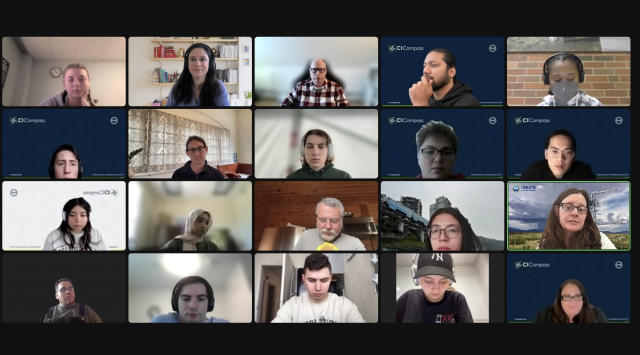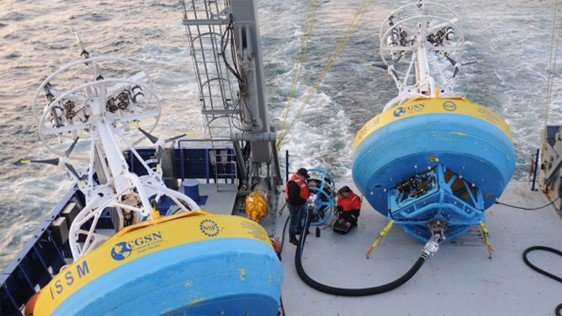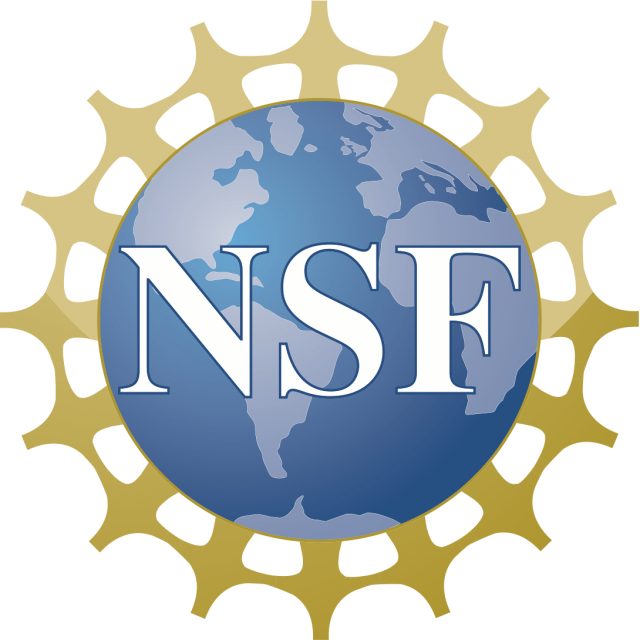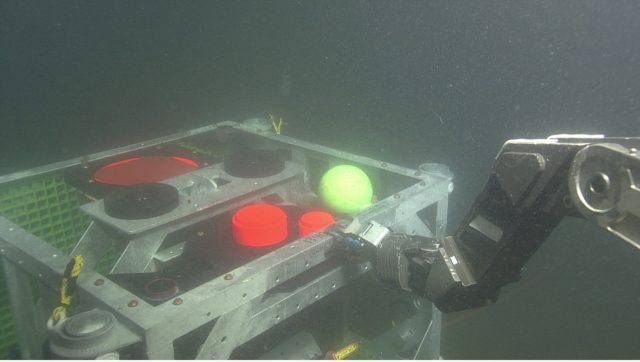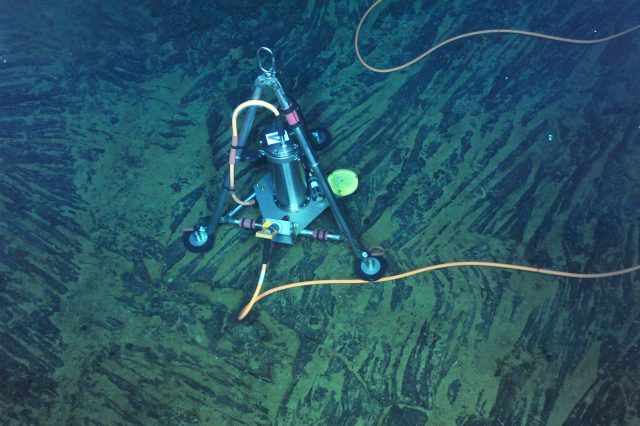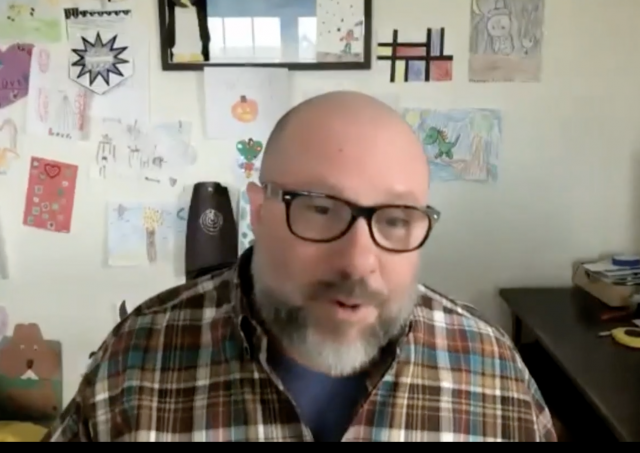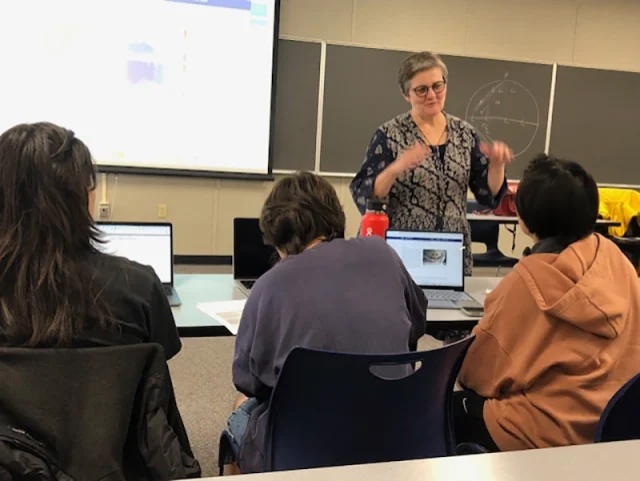Posts by Darlene Trew crist
Sharing OOI’s Cyberinfrastructure with NSF COMPASS Fellows
On Thursday March 7, 2024, Senior Manager of Cyberinfrastructure and OOI Data Lead Jeffrey Glatstein introduced a group of 18 students and seven instructors in the National Science Foundation’s CI Compass Fellowship Program (CICF) for Undergraduates to the challenges of collecting, distributing, and keeping safe OOI’s vast amount of data. Students Fellows in CICF learn about real-world cyberinfrastructure challenges, and how to begin solving them for NSF Major Facilities
Glatstein first gave the group an overview of the type, amount, and diversity of data OOI collects from more than 900 instruments. The collected data consists of 135 billion rows of numerical data, 1.2 petabytes of raw data and nearly 10,000 hours of high-definition video, 327,000 hours of audio recordings, and 1.28 million digital still images.
He then shared OOI’s data delivery track record. Since 2016, OOI has responded to 987 million requests for calculated data, providing 333 terabytes of data.
[media-caption path="https://oceanobservatories.org/wp-content/uploads/2024/03/240307_OOI-Jeff-Glatstein_3.png" link="#"]Senior Manager of Cyberinfrastructure and OOI Data Lead Jeffrey Glatstein (green highlighted screen) discussed OOI’s cyberinfrastructure with 18 COMPASS Fellows and their instructors. Credit: CICF.[/media-caption]Glatstein then went into detail about OOI’s extensive cybersecurity measures, which includes multiple storage sites with duplicate data to ensure that if the primary system went down, it could be quickly restored. This is particularly important for OOI because its stores data for posterity for future use in long-term time-series.
The students were amazed and engaged, as demonstrated by multiple questions after the presentation. Said Glatstein, “I enjoy sharing our work with students. It helps open their eyes to career opportunities in unexpected areas, like the ocean sciences, and their questions provides another way into looking at the work that we do.”
Read More
National Lab Researchers Working on Wave Energy Converter for Pioneer
The Water Power Technologies Office of the US Department of Energy’s Office of Energy Efficiency and Renewable Energy announced that Sandia National Laboratories, in partnership with Woods Hole Oceanographic Institution, is working to develop a wave energy converter (WEC) that can support the Coastal Pioneer Array, one of five arrays that make up the U.S. National Science Foundation Ocean Observatories Initiative.
The WEC will serve the Coastal Surfacing Mooring (CSM) system, which currently relies on solar, wind, and battery systems to power multiple sensors on the buoy itself and along the mooring line. These existing energy resources meet the system’s full power demand about 70% of the time. To satisfy the full power demand 100% of the time and prevent interruptions to data streams, Sandia has been investigating designs for WECs that could provide additional electrical power to the CSM.
Read more here.
Read MoreNSF Announces Solicitation for OOIFB Support Office
Bio-acoustic Sonar Echograms
The U.S. National Science Foundation Ocean Observatories Initiative (OOI) deploys bio-acoustic sonar instruments at all Arrays. Modified Kongsberg EK-60 instruments (ZPLSC-B) are deployed at the OOI Regional Cabled Array (RCA) on the seafloor at the OOI Endurance Array Oregon Shelf site (80 m depth) and at 200 m depth on the cabled mooring at the OOI Endurance Array Oregon Offshore site (Fig. 1). The EK-60s are being replaced with the newer EK-80 instruments, which came online during Summer 2023. ASL Environmental Sciences AZFP instruments (ZPLSC-C) are mounted on Surface Mooring Multi-Function Nodes (MFNs) at the Endurance Array Oregon and Washington Inshore sites and the Washington Shelf and Offshore sites, and formerly at the Pioneer NES Array Inshore, Central and Offshore sites (Fig. 2). At the Global Arrays (Irminger Sea, Station Papa, and formerly Argentine Basin and Southern Ocean), upward and downward looking AZFP instruments (ZPLSG-A) are mounted in the top spheres of the Hybrid Profiler Moorings (~150 m depth).
[media-caption path="https://oceanobservatories.org/wp-content/uploads/2024/03/ROPOS.jpg" link="#"]Figure 1. Upper: The ROPOS ROV releasing the tungsten carbide calibration sphere on the Oregon Shelf (80 m) bioacoustic sonar platform. The EK60 transducer heads are orange. Credit: UW/NSF-OOI/CSSF; Dive R1792; V14. [/media-caption] [media-caption path="https://oceanobservatories.org/wp-content/uploads/2024/03/Jason.jpg" link="#"]Figure 1. Lower: The Jason ROV hovers above the Oregon Offshore Shallow Profiler platform in 200 m water depth, amid a swarm of krill. The neon orange EK80 sonar transducer heads are visible on the far left. Credit: UW/NSF-OOI/WHOI, Dive J2-1516, V23.[/media-caption]The bio-acoustic sonar data are best visualized using echograms, which require processing the data then plotting the data products. In order to provide more accessible data products to the science community, OOI is generating echograms using the Python package Echopype. The Python code used and developed by OOI to generate the echograms via Echopype is freely available on GitHub. Data from the Endurance, Pioneer, and Global ASL AZFP instruments are processed from recovered instrument data, post-deployment. (Data Explorer refers to this as “Recovered Host” data.) The processing generates daily and weekly NetCDF files of the processed data as well as weekly echograms (Fig. 3), all available in the OOI Raw Data Archive (see the above-referenced GitHub README for file paths). Comparable processing will occur with data from the RCA Kongsberg EK-60 and EK-80 instruments; however, the processing will occur daily as new data are delivered to shore. In addition, the converted raw data files, formatted following the ICES SONAR-netCDF4 convention and produced by Echopype, are also in the Raw Data Archive.
[media-caption path="https://oceanobservatories.org/wp-content/uploads/2024/03/Transducers.jpg" link="#"]Figure 2. Picture of the ZPLSC-C transducers mounted on the Pioneer Central Surface Mooring MFN. The transducers are angled at 15 degrees away from the mooring riser to reduce interference. © WHOI.[/media-caption]The Echopype-generated NetCDF files from the Raw Data Archive are compiled into the longer time-series visualizations and are available in Data Explorer. More data have been added since our online July 2023 Town Hall, with a recorded version here.
For more information about research using bio-acoustic sonar data, and using the Echopype software, see this excerpt from the OOI Science Plan, 2021. Another example using raw data can be foundhere.
[media-caption path="https://oceanobservatories.org/wp-content/uploads/2024/03/Eclipse.png" link="#"]Figure 3. Example echogram from the RCA managed, Coastal Endurance, Oregon Offshore Cabled Shallow Profiler Mooring (CE04OSPS). Data were collected from 2017-08-20 through 2017-08-27. Of special note is the total solar eclipse that occurred on 2017-08-21. The path of totality passed directly over this site on the morning of 2017-08-21. The response of the zooplankton to the changing light levels can be seen in a brief reversal of the diel vertical migration as the eclipse reached totality at 18:16 UCT (as shown in area with dotted white lines).[/media-caption]
Read More
Pioneer MAB Array Workshop Applications
Old Dominion University, Norfolk, VA
The Ocean Observatories Initiative Facility Board (OOIFB) will host a community workshop focusing on current and future initiatives that can be addressed using data from the National Science Foundation’s (NSF) OOI Coastal Pioneer Array, which is planned to be relocated to the Southern Mid-Atlantic Bight. The workshop will be held at the Webb University Center, Old Dominion University, in Norfolk, VA, on September 10-12, 2024.
The event will bring together a diversity of scientists, resource managers, educators, and other stakeholders to learn about the capabilities of the Coastal Pioneer MAB Array and the cutting-edge research that can be done in this new location. The workshop also will provide a forum to facilitate cross-network collaborations, identify strategies for better engaging current and future users of the NSF’s OOI, and foster the research and proposal development process. NSF OOI Program team members and NSF representatives will be on hand to answer questions and provide information on NSF OOI operations.
Researchers who are using or are considering using NSF OOI data; resource managers from national, state, and tribal agencies; and educators at all levels interested in using data from the NSF OOI Coastal Pioneer MAB Array are encouraged to participate in this community workshop. To apply for the workshop, please complete the online application form that is available on the workshop web page. Travel support is available, but limited. Broad representation from institutional, geographic, and disciplinary groups is desired and will be considered in participant selection. The deadline for applications is March 26, 2024.
Additional details about the workshop and agenda are available here. If you have any questions, please be in touch.
Is Axial Seamount Napping?
Oregon State University Researcher Bill Chadwick attempted to answer this question in a poster he presented at AGU in December 2023. Chadwick has been watching the “ups and downs” of Axial Seamount for more than 30 years, including its last eruption in 2015. He and other observers monitor the seamount’s activity using bottom pressure recorders (BPR) connected to the US National Science Foundation Ocean Observatories Initiative (NSF OOI) Regional Cabled Array (RCA), operated by the University of Washington, along with additional uncabled BPRs and Mobile Pressure Recorder surveys at an array of seafloor benchmarks every two years using a remotely operated vehicle.
[media-caption path="https://oceanobservatories.org/wp-content/uploads/2024/03/BPR-scaled.jpg" link="#"]A repeatable inflation-deflation cycle has been documented at Axial Seamount over the last 30 years, using autonomous, battery-powered Bottom Pressure Recorders (BPRs), and later cabled-BPRs like this one connected to the OOI-RCA. Credit: UW/NSF-OOI/CSSF, 2014.[/media-caption]“Axial Seamount has erupted three times in the last 25 years. As of March 2024, the seamount is 90-95% reinflated to the level it reached before the 2015 eruption, so we’re getting close to the eruption triggering point,” said Chadwick. “But on the other hand, the rate of inflation, which started high right after the 2015 eruption, has been decreasing and decreasing since then.”
The inflation rate reached nearly zero last summer (just slightly positive at ~1 cm/year, the lowest rate seen at Axial). “At that very low rate, it was hard to tell how long it would take to reach the 2015 inflation threshold,” Chadwick added.
Since October 2023, however, the rate of uplift has been slowly increasing. University of Washington Researcher William Wilcock’s Axial Seamount Earthquake Catalog page also indicates the seismicity has been on the rise since October 2023, with a large swarm of >600 events on 10 February.
“Since October 2023, the rate of inflation has increased a bit to 5-6 cm/yr, which is still quite low compared to rates we’ve seen over the last 25 years but seems to indicate that Axial may be coming out of its slumber of last summer,” Chadwick explained. “And the earthquake swarm on Feb 10 also seems to support that notion.”
Longer-term eruptive history documented by mapping and dating lava flows at the summit shows that Axial has produced at least 50 eruptions in the last 800 years, (Clague et al., 2013), an average of one every 15-18 years, suggesting that the current lull at Axial might not be long.
“I’m hoping that the rate of inflation will continue to increase, but it’s too early to tell. Anything could happen,“ Chadwick added. “I’m more hopeful than I was a year ago that the next eruption may not be too far off but only time will tell!”
[media-caption path="https://oceanobservatories.org/wp-content/uploads/2024/03/Chadwick-dots.jpg" link="#"]Map showing the locations of Mobile Pressure Recorder (MPR) benchmarks, as well as the autonomous and cabled Bottom Pressure Recorders (BPR). The red dots are the BPRs connected to OOI Regional Cabled Array.[/media-caption]
Reference: Clague, D.A., et al., (2013) Geologic history of the summit of Axial Seamount, Juan de Fuca Ridge, Geochem Geophys, Geosystems, doi: 10.1002/ggge.20240.
Read More
Jupyter Hub Town Hall Video Available
In case you missed it, here is a video of the Jupyter Hub Town Hall on March 6, 2024.
To gain access to OOI Jupyter Hub, new users need to register email address at: helpdesk@oceanobservatories.org.
The Jupyter Hub url is: https://jupyter.oceanobservatories.org.
[embed]https://youtu.be/tGn9hGdenfw[/embed] Read MoreCommunicating with Colleagues Teaching with OOI Data
The Ocean Observatories Initiative (OOI) and the OOI Ocean Data Labs are serious collaborators. While two different NSF-funded initiatives share portions of their names, their roles are different, but complementary. The OOI provides data that the OOI Ocean Data Labs Project uses to prepare instructional materials for undergraduate classrooms. It’s a collaboration that helps to expand the use of OOI data into classrooms and into the hands of potential future researchers.
To honor this collaboration, the OOI has launched a new Discourse forum “OOI in the Classroom“ where educators can share their experiences teaching with OOI data and establish dialogues with their colleagues. This forum is designed to offer an online area to share ideas, tell tales, and work to develop supportive, instructive, and challenging classroom experiences.
The OOI Ocean Data Labs also hosted an in-person workshop at the recent Ocean Sciences Meeting to introduce faculty to the community-developed collection of OOI Data Explorations and the online OOI Lab Manual. The workshop invited participants to integrate OOI data into undergraduate courses (Greengrove et al., 2020), to not only teach concepts in oceanography but to build transferable skills.
The Ocean Data Labs is holding a workshop (June 2-5, 2024 at the Marine Science Center, University of North Carolina Wilmington) that will focus on the relocation of the Pioneer Array to the Mid-Atlantic Bight, and the potential this move will provide for future educational lessons and student research activities. Learn more and apply to attend. Participants will be selected and notified by mid-April.
Another way to get involved is to join the Ocean Data Labs mailing list to learn of the latest innovations and lesson plans developed by this network of educators. Also, be sure to sign on to Discourse to continue the ongoing conversation within the education network of OOI data users.
Read MoreJupyter Hub Town Hall: March 6, 1 pm ET
Curious about Jupyter Hub, which gives users access to computational environments and resources in their own workspaces on shared resources?
OOI is hosting a virtual town hall on Wednesday March 6, 2024 at 1 pm Eastern, where you can learn how researchers and educators are using OOI’s Jupyter Hub in their research and classrooms. During this one-hour town hall, OOI Data Lead Jeffrey Glatstein, OOIFB Chair and Queens College Assistant Professor Dax Soule, and OOI Data Expert Stace Beaulieu will give hands-on demonstrations of OOI Jupyter Hub. The emphasis will be on practical applications of this important resource, with plenty of time to ask questions.
Mark your calendar! Register to add this important resource to your repertoire.
- Date: Wednesday March 6, 20224
- Time: 1-2 pm Eastern
- Location: Zoom Webinar
- Register here.
Read More
Live Data Demos at OOI Booth#210
Join OOI data expert Stace Beaulieu at the Ocean Sciences Meeting as she demonstrates how to use Data Explorer to find, compare, and share OOI data. During each session, Stace will use data from a different OOI array to demonstrate the breadth and depth of data available and how easy it is to access, download, and use. She will demo Data Explorer, followed by plenty of time to answer your questions and use this tool to explore data relevant to your research. On Wednesday morning, she’ll demo JupyterHub so you will have another tool to use OOI data in your research.
Mark your calendar, as follows, and come visit Stace at OOI’s booth #210 at the Ocean Sciences Meeting February 19-22, 2024.
Find, compare, and share OOI data
- Monday Feb 19
3:30-4:00 pm
Global Irminger Sea Array - Tuesday Feb 20
10:00-10:30 am
Coastal Endurance Array
3:30-4:00 pm
Coastal Pioneer New England Shelf Array - Wednesday Feb 21
10:00-10:30 am
JupyterHub demo for AUV data from Coastal Pioneer New England Shelf Array
3:30-4:00 pm
Global Southern Ocean Array - Thursday Feb 22
10:00-10:30 am
Regional Cabled Array
A complete list of OOI-related events at the Ocean Sciences Meeting 2024 can be found here.
Read More

